Hitting the Streets of New Capenna, Part 1
Welcome to my first Streets of New Capenna preview article. Today, I'll start by telling you the story of the set's design and then show off two cool preview cards. Hope that sounds fun.
All in the Families
The story of Streets of New Capenna's design starts with this image:
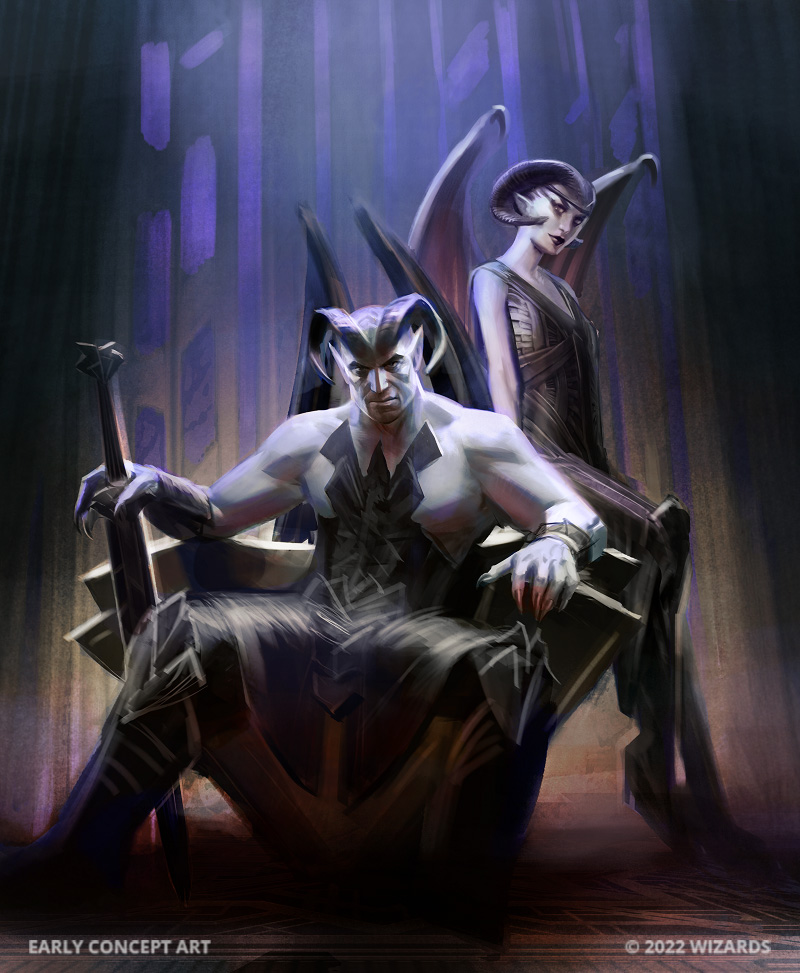
The Creative team will brainstorm on new plane ideas and then create what we call an "art plate," which is basically a cool image that sells the mood and tone of a plane. This art isn't planned to be used in a set, but rather is a kind of proof of concept visually to help people get a general sense of the plane's vibe. I like to think of it as a teaser of a possible new plane. The name associated with the image was "Demon Mobster World," and I think the initial idea was that it's a plane with a '20s art deco vibe where demons and angels are in a constant war with one another.
We were having a meeting where we were talking about the future, and Bill Rose (the vice president of tabletop Magic) put up a slide for the next couple of years of sets after what we were currently working on. It was tentative, but it had some guesses at where we might be going. Mark Gottlieb saw the picture for Demon Mobster World and got an idea, such a strong idea, that in the meeting he wrote an email to Ken Troop, the person who oversees the day-to-day running of tabletop Magic. Here is that letter (in bold) in its entirety. As you read it, I'm going to jump in from time to time to explain things.
Here's a pitch based on Bill's three-color suggestion.
We move Vryn set 1 to F. (Vryn set 2 stays in I; I think that separation between Vryns is fine.)
We move Demon Mobsters to H, between Innistrad and Vryn 2.
As I said above, a lot of this planning was tentative. One of the plans was to have two back-to-back sets on the plane of Vryn, Jace's homeworld. That ended up not happening. The letters refer to premier slots. "F" was "Fencing," which would end up becoming Strixhaven: School of Mages. "I" was "Ice Skating," which would end up becoming Streets of New Capenna. "H" was "Hockey," which would become Kamigawa: Neon Dynasty.
I want to stress that it's normal for there to be a lot of flux for the far future. We tend to start with some big-picture ideas that evolve as we get a better handle on what we want to do. We've learned it's best to put something in each slot, as it gets everyone talking and encourages the discussions that we need to get more concrete ideas. In this case, the core idea was creative, but we also have sets where the starting germ of an idea is mechanical. Strixhaven: School of Mages, for example, began as an enemy faction plane that focused on spells and MDFCs (most of which were spells on one side).
Demon Mobsters is not a tribal set, which backs off Innistrad. It IS a faction plane—we have five three-color factions, each representing a different crime organization!
The vague initial pitch was that the plane would be tribal because it cared about Demons and Angels. It was tentatively scheduled to be a three-color set—I assume arcs (aka shards as we called them on Alara). One of the concerns that came up in the meeting was a worry that the set would feel too close to Innistrad in tone, so Bill had expressed an interest in finding ways to differentiate the two. Because we've done a lot of planes, this is always a concern when talking about new ones. Can we find a way for it to be distinct and not feel like just an extension of an existing plane?
What follows are Mark Gottlieb's initial ideas for each of the five families. What's interesting is how close he got with the basic factions. For each one, I'm going to show you Mark's description (in bold) followed by the description of the guilds that appears on the packaging, and then I'll talk about how we thought about each one.
WUB – Information Brokers. Dealers and conduits of knowledge as a commodity. They stay off front-line fighting, but they wield leverage behind the scenes. Blackmail & soft coercion.
The Obscura (Gifted Magicians) – The Obscura are talented wizards and mystics who use their power to deceive and blackmail. Using distractions, illusions, and hidden mechanisms, they orchestrate scenarios and manipulate outcomes to their benefit. They endeavor to maintain a facade of normalcy in their everyday lives, which allows them to run their schemes without disruption.
This is the blue-centered family (and yes, this list is in the order Mark used in the email, which was based on the mana costs and not the center color, making my color pie sensibilities cry out), so it was the family that cares most about information and uses it in a criminal matter. Mark understood instinctively that this was a crime plane and that each faction wanted to play into a different sub-trope of the genre. The Obscura started as the family invested more in heists (think Oceans Eleven) but shifted to be a little more about information brokering than stealing. They control things from behind the scenes.
UBR – Murder Squad. Wholly ruthless and brutal. Plenty of internecine conflict, as mid-level bosses scheme and struggle to rise to the top.
The Maestros (Elite Assassins) – The Maestros are old-money vampires who love the finer things in life—and are willing to kill to get them. They maintain a public front as an upstanding organization of art aficionados with a goal of preserving the art and culture of Old Capenna. Beneath this polished veneer, they are a shadowy organization of elite assassins focused on maintaining power, influence, and wealth.
This is the black-centered family, so it focused on the criminals that kill people, often, but not always, for money (think John Wick). This was the most ruthless of the five families. I do like that the Creative team gave them a love for art and culture, so it taps into the trope space of the criminals compartmentalizing their lives. When they're working, they kill people, but on their off time, they have their own passions.
BRG – Street Brawlers. Vandals, street-savvy toughs. Less centralized leadership, but highly territorial. Impulsive, hot-headed, rumbling for a fight.
The Riveteers (Destruction Workers) – The Riveteers are tough-as-nails artisans who can break buildings as easily as kneecaps. They're a rowdy, brute-force crime faction whose skills in industry and construction also make them pros at demolition and intimidation. As skilled artisans, they've transformed the lower levels of the city into a lair worthy of their draconic leader.
This is the red-centered family, so it focuses on people who commit crimes in the heat of the moment rather than crimes that are carefully thought out. Mark used this group to hit the trope of crime on the street (think The Warriors), but it got shifted a bit to people responsible for building the city infrastructure, artisans and builders, rather than leaning into things like street gangs, as that reinforced some stereotypes we wanted to avoid.
RGW – The Family. Everyone here is basically (maybe literally?) related. Puts the "organized" in organized crime. Values loyalty. Tight-knit.
The Cabaretti (Party Monsters) – The Cabaretti are a fun-loving cult of druids who throw the hottest parties in town. They are the glitterati of the city, and everyone wants to be invited to their feasts and dance halls. They use ancient magic to sway the opinion of the masses and keep the Halo flowing. The party never ends if you keep paying, but the moment you stop, you might find it hard to leave.
This is the green-centered family, so it focuses on larger crime organizations, ones with a sense of history and tradition. Early on, it leaned more into organized crime (think The Godfather) but shifted to be more about the groups that run the nightclubs, the center of the entertainment in the city. As a running theme, we were sensitive to capture crime tropes without playing into unnecessary stereotypes.
GWU – Corrupt Cops. Ostensibly the law-enforcement force, they use their authority to control as much as they can (and reward themselves in the process).
The Brokers (Demonic Lawyers) – The Brokers are a demonic law firm that secretly believes a doomsday prophecy—when the Halo dries up, New Capenna will fall. They maintain public law offices where they handle mundane legal matters like property disputes and physical grievances, but their aggressive solicitors have a dubious reputation for being everywhere and showing up at every crisis within the city.
Okay, now we get to the biggest change. This was the white-centered family, so it played up the idea of using order to do crime. The faction in its earliest incarnation played up the trope of crooked cops (think LA Confidential), so it represented the police of the city. Looking at the real world and all the associations going on with police, we decided to shift away from police and toward lawyers. Evil lawyers out to use the law to accomplish their own criminal agenda had its own trope space (Wolfram & Hart from the television show Angel is an example in this space), so we chose to go in that direction.
I had never seen this document until Gottlieb sent it to me when we were talking for this article (I normally chat with the lead vision designer when it's not me). I'm still blown away how in that one moment, he was able to envision, in its entirety, what basically became the framework for the whole set. What would become the focus for exploratory and vision design was how do we mechanically bring each of these factions/families to life. (I'll be covering this aspect of the design next week.)
Paving the Streets
For each set, I sit down with Brady Bell, the manager who oversees most of the designers, to figure out who is going to be on each Vision Design team. This includes deciding who will lead it. For Streets of New Capenna, it was a no-brainer. The vision of this set came from the brain of Mark Gottlieb. He had to be the one to execute on it.
I'm on the Exploratory Design and Vision Design team for each set, but when it's being run by someone else, I set up a weekly one-on-one meeting to talk through how the design is going. My strategy as the person responsible for overall vision design is to make sure each vision design lead understands the tasks they have to accomplish for their set. My job is to tell them what has to get done, not how to do it.
One of the earliest things Gottlieb and I talked about was how to structure this set. With a new plane, we often will create a brand-new structure to reflect what that plane cares about, but in the case of New Capenna, we were going down a path we've gone down before, a three-color faction set. Gottlieb and I decided that Khans of Tarkir had done such a great job of creating a robust set structure (with a big tip of the hat to Erik Lauer, the lead developer of that set) that we didn't need to reinvent the wheel. The plan was to have Gottlieb start with the Khans of Tarkir set structure (with the wedges and enemy combinations traded for arcs and ally combinations) and adapt as needed by the set. While the structure did have small tweaks, it mostly stuck all the way through the design.
The next big thing Gottlieb and I talked about was the trope space of the set. As a color-based factions set, it was a bottom-up design, but a lot of what was going to give the set its charm was tapping into the resonance of the genre of crime. Early in exploratory design, we spent a lot of time talking about every sub-trope of the crime genre, and there are a lot. The goal was to divvy everything up such that each of the five factions, which we dubbed families very early on, would have enough source material to work with.
Also, we spent time making a long list of all the things one would associate with the crime genre. What are the people, objects, events, and places you would expect? What are the words and phrases that we could turn into card names? I believe Mark Gottlieb's greatest strength as a designer is his ability to tap into resonance and make his sets drip with flavor. One of the common notes he got throughout all the playtests for the set was how awesome all the names were on the playtest cards. He, and his design team, did a great job of making sure that expectations for such a set were met, which brings us to my two preview cards.
Both preview cards have names that we knew we wanted in the set. The key was about how best to capture them. Interestingly, the two preview cards are examples of different ways of doing so. One of the decisions we made early on, in conjunction with the Creative team, was to align the technology of the plane with technology that existed in America during the Roaring Twenties (as this was the setting for a bunch of tropes we were copying). This meant, for example, that we had access to cars. Well, if we had cars, and we were doing a crime-themed set, we had to have a Getaway Car.
Click here to show Getaway Car
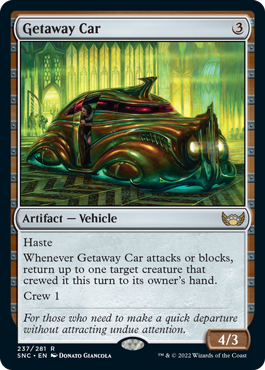
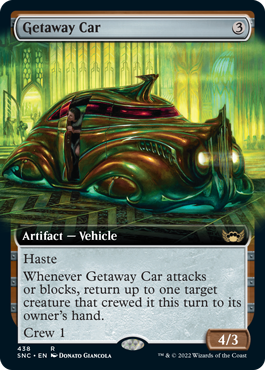
This card was designed top down from the name. The thought behind it was that we wanted the Getaway Car to be easy to crew, as you needed to get away at a moment's notice, but that meant there had to be a cost other than the crew. Bouncing one of the crewing creatures to your hand was a fun design because there are lots of ways in the set to turn the cost or drawback into a positive.
Our second preview card also has a flavorful name, but rather than being designed top down, it was created as a cool card mechanically that we later added the name to. In vision design, we'd made a long list of cool card names, so whenever we made a card we liked, we checked the list to see if any of those names worked for it. That said, click below to see Cut of the Profits.
Click here to show Cut of the Profits
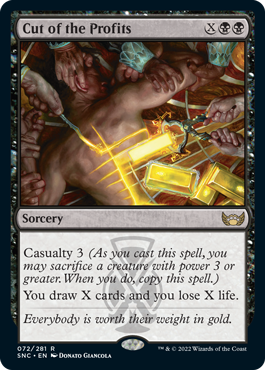
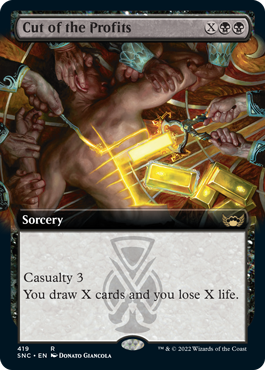
This card came about because we were trying to find cool ways at rare to execute on the Maestro's faction mechanic, casualty. (I'll be talking more about the creation of this mechanic next week.) One of the great things about the trope space of the crime genre is that it came with a host of great words and phrases.
That's all the time I have for today. I hope you're enjoying getting to know Streets of New Capenna. As always, I'm eager to hear your thoughts on today's column, any of the stories I've told, or on the set itself. You can email me or contact me through any of my social media accounts (Twitter, Tumblr, Instagram, and TikTok).
Join me next week when I talk about how we mechanically brought each family to life.
Until then, don't get into too much trouble exploring New Capenna.
#919: Oath of the Gatewatch with Ethan Fleischer
#919: Oath of the Gatewatch with Ethan Fleischer
31:04
I sit down with Designer Ethan Fleischer to talk about the design of Oath of the Gatewatch.
#920: Managing the Rules with Jess Dunks
#920: Managing the Rules with Jess Dunks
32:53
I sit down with Designer and Rules Manager Jess Dunks to talk about the challenges of managing the rules and dealing with me as head designer.
- Episode 918 Stories from Japan
- Episode 917 Lorwyn with Aaron Forsythe
- Episode 916 Card Frames

